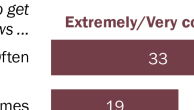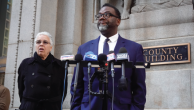Digital technology plays a role in the news environments of all three metropolitan areas studied, though not an equal one. A number of factors, including internet access, demographics and the news offerings that are available play a part in the development of digital news habits.
Denver: A Digitally Enabled City
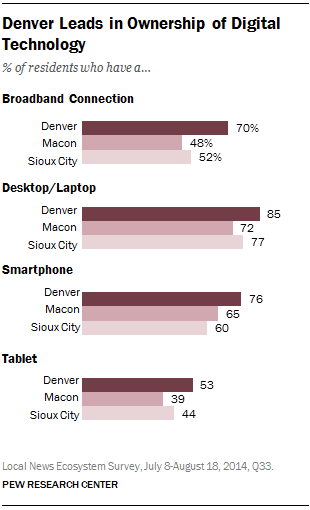
Two of the most fundamental elements at play are device ownership and internet access, both of which have a strong link to higher levels of education and income. By these measures, Denver—a tech startup hub that is headquarters to MapQuest and Photobucket, among others—clearly stands apart.
The Denver population is more affluent and more highly educated than that of Macon or Sioux City and also owns various digital devices at higher rates. Fully 85% own a laptop or desktop computer, 76% own a smartphone and 53% own a tablet. These ownership rates surpass Macon and Sioux City by eight to 16 points. In fact, residents of Denver are more likely to own a smartphone and a tablet than the nation overall.29
Denver residents also report higher levels of broadband adoption and internet use than Macon or Sioux City residents. Seven-in-ten Denver-area residents (70%) report having a broadband connection in their home, compared with only about half of Macon (48%) and Sioux City (52%) residents. And while majorities in each city use the internet at least occasionally, Denver residents do so at higher rates (89%) than Macon (76%) or Sioux City (80%) residents.
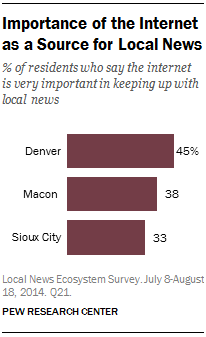
Denver’s news offerings reflect the area’s digital orientation, including nearly 40 neighborhood and municipal websites offering regular news items as well as at least 25 digital-only news outlets and blogs. Digital-only outlets produced 75 stories in the five-day period studied. In stark comparison, researchers could not find a single “digital-native” outlet in Macon or Sioux City that produced local, original material on a weekly basis during the content analysis sample period.
The digital focus occurs in both large and small outlets. The Denver Post, alongside its numerous blogs and online podcasts, operates standalone sites (The Cannabist and Reverb) that publish several times a day. But aside from those, the city is served by nearly two dozen digital-only news outlets, covering a range of subjects such as real estate and development, health, and education. Nearly half of these publish new, local news content daily on their home page.
Amidst these digital opportunities, the Web emerges as more a part of the fabric of local news in Denver—not by leaps and bounds but by layers of gradation.
About eight-in-ten Denver residents (79%) get local news on at least one digital device, compared with 69% in Sioux City and 67% in Macon. And, nearly half of Denver residents (45%) say the internet is very important in their ability to keep up with local news issues and events, compared with 38% in Macon and 33% in Sioux City.
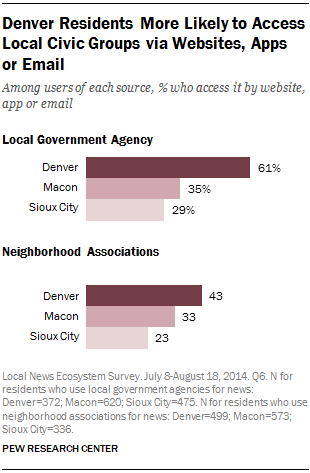
Further, more Denver residents have shared a local news story digitally in the past year (54%) than have residents in Macon (36%) and Sioux City (40%).
Denver residents also stand out for accessing non-journalistic providers of news through the Web. Among Denver residents, 44% ever get news from a neighborhood association. Of those who do, 43% access this news through their website, app or email, compared with 33% of users in Macon and 23% in Sioux City. For those who get news from local government agencies, about six-in-ten (61%) in Denver say they access them by the Web—much higher than in Macon (35%) and Sioux City (29%).
While legacy outlets and platforms still attract the greatest portion of the population in Denver, these data reveal a city with more rooted digital habits—particularly in the first generation of the digital experience of desktop and website connections.
Macon: The Importance of Social Pathways to Local News

The metropolitan area of Macon, Georgia, faces at least one digital obstacle not encountered in Denver or Sioux City. According to data from the Federal Communications Commission (FCC), nearly all residents in Denver (98%) and Sioux City (96%) have access to an internet connection that meets the FCC definition for a “broadband” internet connection by modern standards.30 In Macon that falls to 84%—still a vast majority, but lower than the other two cities.31
The array of digital news offerings in Macon is far more limited than that of Denver and is closer to being on par with Sioux City. One of the area’s only digital-native news sites closed in 2014. While the majority of local news outlets have some sort of web presence, just six of the 24 news providers studied were publishing online content daily. Four of the local news providers identified by researchers did not publish local news online at all (a fifth did, but its content was placed behind a pay wall). Still, efforts are afoot to connect the community through technology, such as the Center for Collaborative Journalism at Mercer University, home to Groundsource, a tool for mobile engagement.
Despite a less digitally enabled infrastructure, Macon residents’ reliance on digital news tends to lie between that of Denver and Sioux City residents. And when it comes to social networking sites, Macon residents show early signs of outpacing both Sioux City and Denver.

While the same share of residents in each city (8%) say that social networking sites are the most important way they get local news, Macon residents are more likely to name specific sources that they turn to in this space. Fully 35% of Macon residents access a news source through a social networking site, outpacing both Denver (25%) and Sioux City (27%).
Looking at specific sources of news, 17% of Macon residents who get news from local TV channels do so through social media, compared with 10% of residents in Denver and 13% of those in Sioux City. A similar pattern emerges for local radio. Macon residents who read the daily newspaper (18%) are just as likely as Sioux City residents (18%), but slightly more likely than those in Denver (13%), to access the daily paper through social media. A similar pattern is found with all other print-based publications, such as magazines, as well as digital news outlets and neighborhood associations.
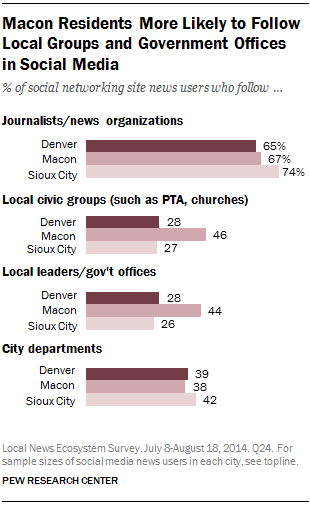
A subset of the total population in each city—residents who get news on a social networking website—were asked a series of questions about who they follow. And here, Macon stands out for its use of social media as a way of connecting to news from nontraditional types of news providers.
Solid majorities of these social news users in each city follow local news organizations, reporters or commentators, but Macon’s social news users are more likely to follow other kinds of local groups. More than four-in-ten of them (44%) follow local leaders or government agencies, compared with 28% in Denver and 26% in Sioux City. Similarly, nearly half (46%) of social news users in Macon follow local groups such as the PTA or churches, compared with 28% of Denver users and 27% of Sioux City users. Users in all three cities are similar when it comes to following city departments.
Race as a Contributing Factor in Macon
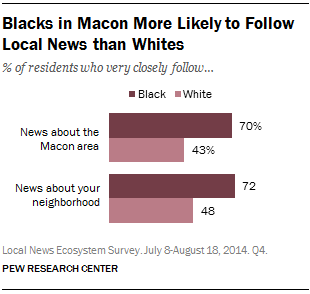
That Macon keeps apace with Denver, and in some cases surpasses it when it comes to local digital news behaviors, is notable given the more limited access its residents have to digital technology and news offerings. Some of this could be tied to the finding that Macon-area residents in general follow local news more closely than those in Denver or Sioux City—overall and for a number of specific news topics.
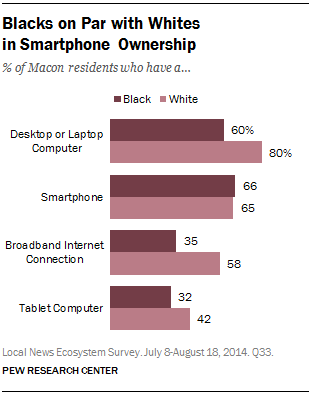
This strong interest in local news particularly stands out among the black population in Macon. Seven-in-ten blacks in Macon follow news about the local area very closely, compared with less than half (43%) of whites. Blacks are also more likely than whites to say they follow neighborhood news very closely (72% vs. 48%).
And while white residents in Macon are more likely to own a desktop computer (80% vs. 60%) or tablet (42% vs. 32%), have broadband internet (58% vs. 35%), or use the internet at least occasionally (82% vs. 67%), blacks are on par with whites when it comes to smartphone ownership. Smartphone ownership among blacks in Macon is on par with their ownership of desktop/laptop computers (65% vs. 60%).

The reliance on smartphones may be tied to another area where blacks in Macon stand out—their use of social media for news. Traditional pathways like print and broadcast still dominate, but among daily newspaper users in Macon, blacks (24%) are more likely than whites (14%) to access the paper through social media. About a quarter of Macon blacks (25%) who use other kinds of print publications do so through social media, compared with 9% of whites. And more blacks who use local radio news sources accessed those sources through social media than do white audiences (13% vs. 6%). (For local TV, digital-only outlets, local government agencies and neighborhood associations, the access points were similar for both groups.)
The racial divide offers a less clear pattern when it comes to other digital access points such as websites, apps and email.
Though the numbers are small across the board, blacks in Macon are also more inclined than whites to use digital technology to discuss local news, with 13% of black residents discussing local news nearly every day by text or instant message, compared with a mere 4% of whites. They are also more likely than whites to use social networking sites and email to talk about local news with others.
Sioux City: A More Traditional Local News Experience
Despite having roughly equal broadband access as Denver, Sioux City on many fronts reflects less of a digital orientation than Denver or Macon.
As in Macon, there is little by way of local digital publishers. Sioux City Now is the rare hyperlocal blog that focuses on local issues. There are statewide sites, such as IowaWatchdog.org and Iowa Cold Cases that occasionally cover Sioux City affairs, but their focus is generally much broader. Only seven of the 24 websites studied updated their home page at least daily. Just 11 had comment sections on their home page, none of which contained any user comments during the period studied.
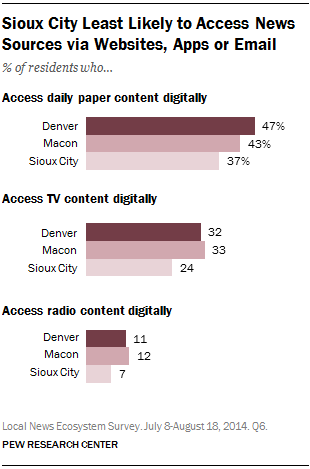
Sioux City residents are the least likely to say the internet is very important for keeping up with local news (33%, compared with 38% among Macon internet users and 45% in Denver). And only 22% of Sioux City residents get local news on a desktop or laptop compared with 37% in Denver and 27% in Macon.
Sioux City residents are less likely than those in the other two cities to access local TV or the daily paper through websites, apps or email.
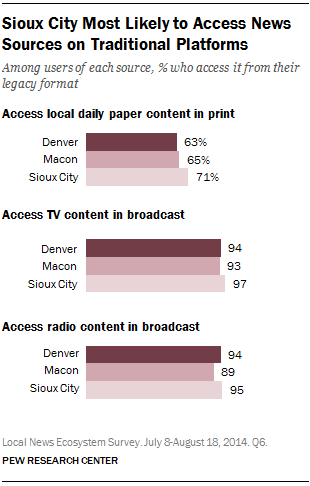
About a quarter of Sioux City residents who get news from local TV (24%) access that content through a TV station’s website, app or email, compared with about a third in both Denver and Macon. And 37% of local newspaper consumers in Sioux City say they often get content from the main daily paper via the Web, compared with 47% in Denver and 43% in Macon.
By contrast, Sioux City residents are more likely than those in the other two metro areas to say they access the local daily paper by traditional means. Among Sioux City residents who read the daily paper, 71% access it in print, compared with 63% in Denver and 65% in Macon.
It is not as if Sioux City news functions wholly outside of the digital realm. The local daily paper updates its website and Twitter feeds multiple times per day, as do the network TV affiliates, though the posting rate at the shared website for the local CBS and Fox affiliates is closer to once a day. The majority of news providers that were identified had regularly updated Facebook pages. And some municipal and government sources of information maintain robust online presences. The official website of Nebraska Rep. Adrian Smith featured new content several times a week.
Still, however, there may be something about the smaller size of Sioux City, and its culture, that lend the population to more traditional ways of gathering information. Rick Arnold, president of the Sioux City Neighborhood Network, argues that in Sioux City, the internet “is not as critical because you’re never very far away from anything.” In his observation, Siouxlanders are “more relationship-oriented, and like to talk.”32

